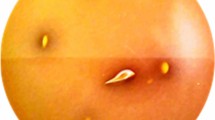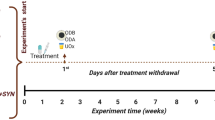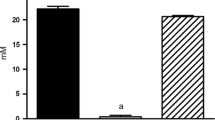Abstract
It had been suggested that lactic acid bacteria (LAB) may degrade oxalate in the intestinal lumen, reducing urinary oxalate excretion. We aimed to evaluate the effect of a LAB mixture containing Lactobacillus casei (LC) and Bifidobacterium breve (BB) (LC + BB) upon urinary oxalate reduction in stone-forming (SF) patients without hyperoxaluria under conditions of an oxalate-rich diet. After an oxalate restriction period (7 days washout), 14 SF patients consumed an oxalate-rich diet during 4 weeks (200 mg/day) and a lyophilized LC + BB preparation was given t.i.d. after meals during the last 2 weeks. Twenty-four-hour urine samples were collected for determination of oxalate, calcium, magnesium, citrate, sodium, potassium and creatinine at baseline, after 2 weeks (DIET) and 4 weeks (DIET + LC + BB). The mean urinary oxalate excretion was significantly higher after DIET versus baseline (27 ± 8 vs. 35 ± 11 mg/24 h), but the mean decrease was not significant between DIET + LC + BB and DIET periods (35 ± 11 vs. 33 ± 10 mg/24 h). Seven out of 14 patients presented a reduction in oxaluria after LC + BB versus DIET, being the reduction higher than 25% in 4, and up to 50% in 2 of them. The latter two patients were those who had presented the greatest increase in oxaluria in response to dietary oxalate. In conclusion, this mixture of L. casei and B. breve was shown to possess a variable lowering effect upon urinary oxalate excretion that may be dependent on dietary oxalate intake.

Similar content being viewed by others
References
Pak CYC (1990) Hyperoxaluric calcium nephrolithiasis. In: Resnick MI, Pak CYC (eds) Urolithiasis: a medical and surgical reference. WB Saunders Company, Philadelphia, pp 65–77
Khan SR (1991) Pathogenesis of oxalate urolithiasis: lessons from experimental studies with rats. Am J Kidney Dis 12(4):398
Baggio B (1999) Genetic and dietary factors in idiopathic calcium nephrolithiasis. What do we have, what do we need? J Nephrol 12(6):371
Conyers RA, Bais R, Rofe AM (1990) The relation of clinical catastrophes, endogenous oxalate production, and urolithiasis. Clin Chem 36(10):1717
Marangella M, Fruttero B, Bruno M, Lirieri F (1982) Hyperoxaluria in idiopathic calcium stone disease: further evidence of intestinal hyperabsorption of oxalate. Clin Sci 63:381
Curhan GC, Willett WC, Rimm EB, Stampfer MJ (1993) A prospective study of dietary calcium and other nutrients and the risk of symptomatic kidney stones. N Engl J Med 328:833. doi:10.1056/NEJM199303253281203
Massey LK, Sutton RA (1993) Modification of dietary oxalate and calcium reduces urinary oxalate in hyperoxaluric subjects with kidney stones. J Am Diet Assoc 93(11):1305. doi:10.1016/0002-8223(93)91961-O
Takei K, Ito H, Masai M, Kotake T (1998) Oral calcium supplement decreases urinary oxalate excretion in subjects with enteric hyperoxaluria. Urol Int 61(3):192. doi:10.1159/000030323
Nishiura JL, Mendonça COG, Schor N, Heilberg IP (2002) Effect of calcium intake on urinary oxalate excretion in calcium stone-forming subjects. Braz J Med Biol Res 35:669. doi:10.1590/S0100-879X2002000600006
Von Unruh GE, Voss S, Sauerbruch T (2003) Reference range for gastrointestinal oxalate absorption test. J Urol 169:687. doi:10.1016/S0022-5347(05)63993-6
Holmes RP, Goodman HO, Assimos DG (2001) Contribution of dietary oxalate to urinary oxalate excretion. Kidney Int 59:270. doi:10.1046/j.1523-1755.2001.00488.x
Taylor EN, Curhan GC (2007) Oxalate intake and the risk for nephrolithiasis. J Am Soc Nephrol 18(7):2198. doi:10.1681/ASN.2007020219
Williams A, Wilson DM (1990) Dietary intake, absorption, metabolism and excretion of oxalate. Semin Nephrol 10:2
Siener R, Hesse A (1995) Influence of a mixed and a vegetarian diet on urinary magnesium excretion and concentration. Br J Nutr 73:783. doi:10.1079/BJN19950081
Ferraz RR, Tiselius HG, Heilberg IP (2004) Fat malabsorption induced by gastrointestinal inhibitor leads to an increase in urinary oxalate excretion. Kidney Int 66:676. doi:10.1111/j.1523-1755.2004.00790.x
Borghi L, Schianchi T, Meschi T (2002) Comparison of two diets for the prevention of recurrent stones in idiopathic hypercalciuria. N Engl J Med 346:77. doi:10.1056/NEJMoa010369
Mendonça COG, Martini LA, Baxmann A, Heilberg IP (2003) Effects of an oxalate load on urinary oxalate excretion in calcium stone formers. J Ren Nutr 13(1):39. doi:10.1053/jren.2003.50002
Von Unruk GE, Voss S, Sauerbruch T (2004) Dependence of oxalate absorption on the daily calcium intake. J Am Soc Nephrol 15:1567. doi:410.1097/01.ASN.0000127864.26968.7F
Sidhu H, Schmidt ME, Cornelius JG, Thamilselvan S, Khan SR, Hesse A, Peck AB (1999) Direct correlation between hyperoxaluria/oxalate stone disease and the absence of the gastrointestinal tract-dwelling bacterium Oxalobacter formigenes: possible prevention by gut recolonization or enzyme replacement therapy. J Am Soc Nephrol 10(14):S334
Ruan ZS, Anantharam V, Crawford IT (1992) Identification, purification and reconstitution of Ox1T, the oxalate:formate antiporter protein of Oxalobacter formigenes. J Biol Chem 267:10537
Kwak C, Kim HK, Kim EC, Choi MS, Kim HH (2003) Urinay oxalate levels and the enteric bacterium Oxalobacter formigenes in subjects with calcium oxalate urolithiasis. Eur Urol 44:475. doi:10.1016/S0302-2838(03)00318-X
Kaufman DW, Kelly JP, Curhan GC, Anderson TE, Dretler SP, Preminger GM, Cave DR (2008) Oxalobacter formigenes may reduce the risk of calcium oxalate kidney stones. J Am Soc Nephrol 19(6):1197. doi:10.1681/ASN.2007101058
Goldfarb D (2004) Microorganisms and calcium oxalate stone disease. Nephron. Physiol 98(2):48. doi:10.1159/000080264
Campieri C, Campieri M, Bertuzzi V, Swennen E, Matteuzzi D, Stefoni S, Pirovano F, Centi C, Ulisse S, Famularo G, de Simone C (2001) Reduction of oxaluria after an oral course of lactic acid bacteria at high concentration. Kidney Int 60:1097. doi:10.1046/j.1523-1755.2001.0600031097.x
Lieske JC, Goldfarb DS, de Simone C, Regnier C (2005) Use of a probiotic to decrease enteric hyperoxaluria. Kidney Int 68:1244. doi:10.1111/j.1523-1755.2005.00520.x
Goldfarb DS, Modersitzki F, Asplin JR (2007) A randomized, controlled trial of lactic acid bacteria for idiopathic hyperoxaluria. Clin J Am Soc Nephrol 2:745. doi:10.2215/CJN.00600207
Heilberg IP, Boim MA, Schor N (2003) Biochemical differences between stone formers and normal subjects. In: Segura J, Conort P, Khoury S, Pak C, Preminger GM, Tolley D (eds) Stone disease (1st international consultation on stone disease), Editions 21. Health Publications, France, p 61
United States of America Human Nutrition Information Service, Department of Agriculture: composition of Foods, raw, processed, prepared foods. Agriculture Handbook 8-series 1–16, revised 1976–1986
Directory listing of/health/Oxalate/files. In: HSPH Nutrition Department’s Oxalate Documentation. http://regepi.bwh.harvard.edu/health/Oxalate/files. Accessed 25 Sep 2008
Hallson PC, Rose GA (1974) A simplified and rapid enzymatic method for the determination of urinary oxalate. Clin Chim Acta 55:29. doi:10.1016/0009-8981(74)90330-1
Holt C, Cowley DM, Chalmers AH (1985) Rapid estimation of urinary citrate by use of a centrifugal analyser. Clin Chem 31:779
Tiselius HG (1991) Aspects on estimation of the risk of calcium oxalate crystallization in urine. Urol Int 47:255
Holmes RP, Kennedy M (2000) Estimation of oxalate content of foods and daily oxalate intake. Kidney Int 57(4):1662. doi:10.1046/j.1523-1755.2000.00010.x
Taylor EN, Curhan GC (2008) Determinants of 24-hour urinary oxalate excretion. Clin J Am Soc Nephrol 3(5):1453. doi:10.2215/CJN.01410308
Prokopovich S, Knight J, Assimos DG, Holmes RP (2007) Variability of Oxalobacter formigenes and oxalate in stool samples. J Urol 178:2186. doi:10.1016/j.juro.2007.06.045
Curhan GC, Taylor EN (2008) 24-h uric acid excretion and the risk of kidney stones. Kidney Int 73(4):489. doi:10.1038/sj.ki.5002708
Acknowledgments
This research was supported by grants from Coordenação de Aperfeiçoamento Pessoal de Nível Superior (CAPES) and Fundação Oswaldo Ramos - Hospital do Rim e Hipertensão. The authors wish to thank Janayna Morandini Pereira for technical assistance. We appreciate the support of Shinya Honda, Yasumi Ozawa Kimura and Julia Keiko Mukai from Yakult SA Indústria e Comércio (Brazil), who provided part of the funding for this trial, including the LAB preparation supply. The investigators were solely responsible for the design, conduct, analyses and publication of the trial. There have been no restrictions on publications and all data were maintained and analyzed solely by the authors.
Author information
Authors and Affiliations
Corresponding author
Rights and permissions
About this article
Cite this article
Ferraz, R.R.N., Marques, N.C., Froeder, L. et al. Effects of Lactobacillus casei and Bifidobacterium breve on urinary oxalate excretion in nephrolithiasis patients. Urol Res 37, 95–100 (2009). https://doi.org/10.1007/s00240-009-0177-5
Received:
Accepted:
Published:
Issue Date:
DOI: https://doi.org/10.1007/s00240-009-0177-5




